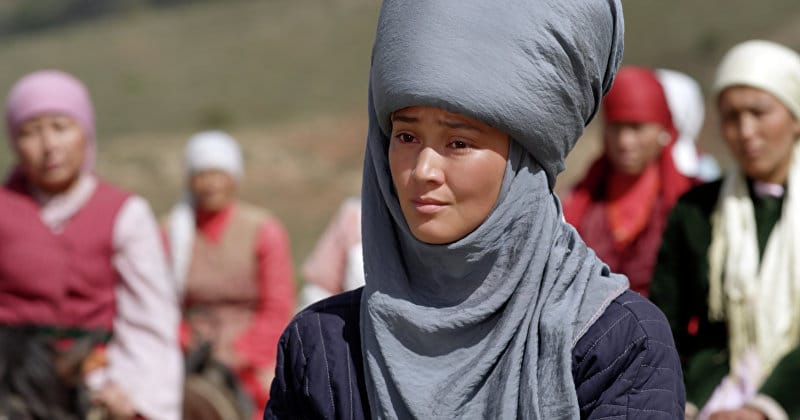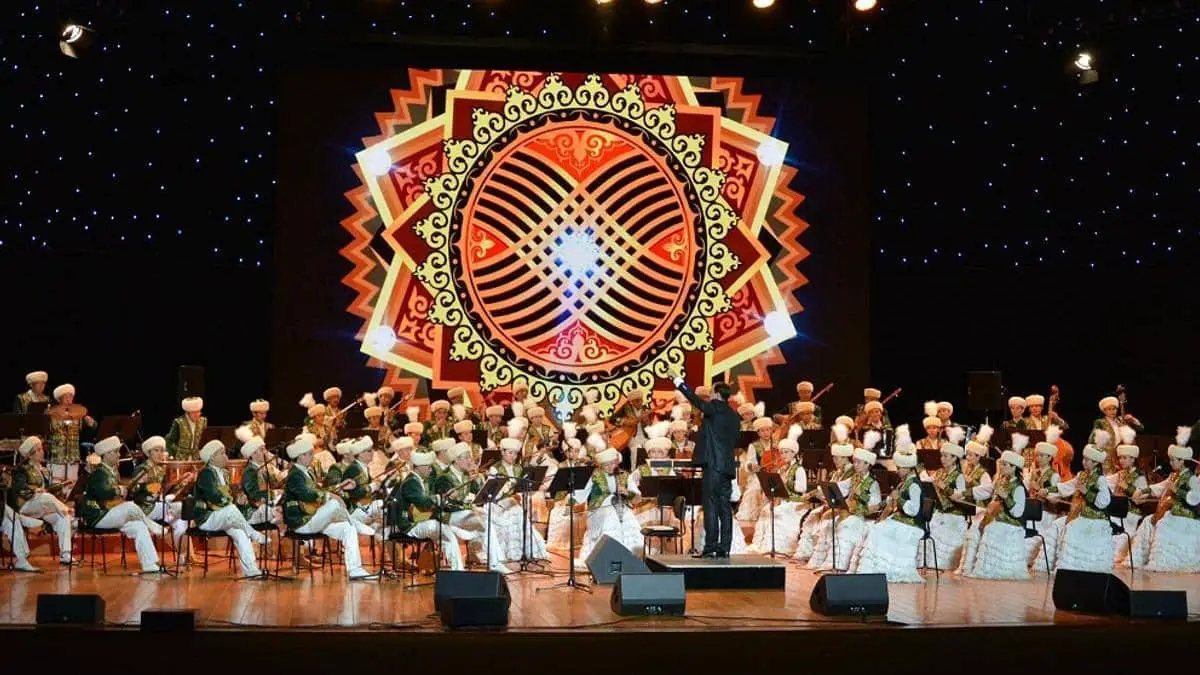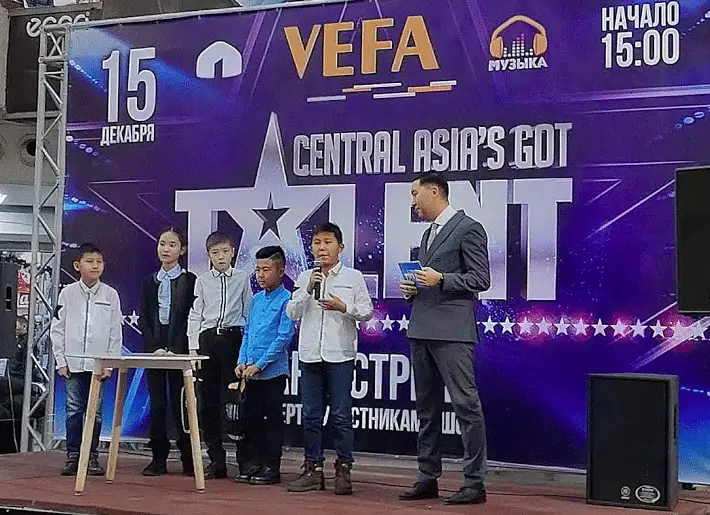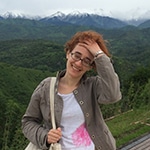Kurmanjan Datka is a historical drama about a woman who helped unite Kyrgyzstan’s fourty tribes into a nation to fight the invading Russian forces. Recently, a modern film was made of her life and deeds. It is called simply Kurmanjan Datka, although it was released with English subtitles with a second name: Queen of the Mountains. The film was funded by the Kyrgyz government as a way to build cultural knowledge and civic identity at home as well as for use in soft power abroad. Thus, it was dubbed into several languages and submitted for consideration to major prizes such as the Oscars and Russia’s Nike Award.
As part of the Central Asian Studies course presented by SRAS and London School, American students watched, discussed, and reviewed the film. You may view it for free, on YouTube, as well. Read three of the best reviews and a synopsis from our students below.
Kurmanjan Datka: Synopsis
By Julie Hersh
SRAS Intern
18 OCT 2016
Kurmanjan Datka (Курманжан датка; also known in English as Queen of the Mountains) is a 2014 Kyrgyz historical drama/biopic. The film tells the story of Kyrgyz stateswoman Kurmanjan—“datka” means “general” in Kyrgyz, but it has political, not just military, connotations—from her childhood to her role in uniting the Kyrgyz people.
The film is entirely in Kyrgyz, with Russian subtitles, and can be hard to follow without some preliminary knowledge of Kyrgyz history. Kurmanjan was born in 1811 and lived almost 100 years, seeing major changes in the Kyrgyz nation—from a loose grouping of different tribes to a more unified people, but under Russian rule. Kurmanjan gained power when her husband, the datka of the Alai Kyrgyz tribe, was killed in an attempted coup and she inherited his position. She became a powerful leader—she is sometimes known as the mother of the Kyrgyz nation, and today she appears on the 50-som note—but ultimately she also allowed Kyrgyzstan to be absorbed into the Russian Empire.
The film takes the viewer through these political twists, but it also takes particular pains to show Kurmanjan’s life as a woman. Her early years are paid careful attention to, particularly her father’s attempt to sell her in marriage to a man she did not want to marry. In an extremely unusual turn of events, she escaped from the marriage and returned to her father. (This is particularly remarkable in the context of the fact that even today, bride kidnapping is quite common in Central Asia.) Later on, her relationship with and difficulties with her two sons are given almost as much screen time as is politics.
While the film has its issues—it was criticized in particular for a loose portrayal of the facts—it is a good look at a Kyrgyzstan many of us know nothing about. It has high reviews from critics and viewers and is seen as one of the greatest accomplishments of independent Kyrgyz cinema. And of course, its many shots of the beautiful Kyrgyz scenery are well worth a watch.
Director: Sadyk Sher-Niyaz (Садык Шер-Нияз)
Stars: Elina Abay Kyzy (Элина Абай Кызы), Nazira Mambetova (Назира Мамбетова), Aziz Muradilaev (Азиз Мурадилаев), Adilet Usubaliev (Адилет Усубалиев), Mirlan Abdulaev (Мирлан Абдулаев)
Production company: Aitysh Film, Kyrgyzfilm
Kurmanjan Datka: the Voice of a Woman and Strength of a Mother
By Erin E. Gustafson
Central Asian Studies
26 MAR 2020
By the khans of Bukhara and Kokand, Kurmanjan was declared “Datka” following the assassination of her husband, Alymbek. As a woman, a submissive counterpart to the man’s dominant status of the nineteenth century, Kurmanjan spent the majority of her life defending both her geographic home of the Alai nation and the people in it. Her leadership was defined by effective political negotiations and critical decision making in patriotic defense against Russian invasion. In doing so, she gained support from the native people by treating them as her own sons. This matriarchal role in political and militaristic power proved an effective strategy in the protection of her nation.
The film, spanning the course of Kurmanjan’s ninety-six years, parallels her independence to that of a tiger. This tiger, appearing in moments of Kurmajan’s own perseverance and willpower, serves as a symbolic representation of solidarity and strength of her people. Tigers represent courage and personal strength, which is a critical aspect of this film in its literal and figurative story-telling. For example, Kurmanjan never consummated her arranged marriage and fled, demonstrating her will for what is right. In her escape, a parallel of her and her horse in a river is made with the tiger. This is also shown in a horseback chase, where the tiger spooked her pursuer as she fled. Her decisiveness and leadership skills saved many lives, and in doing so, she amassed a large following of people who believed in her. Her voice was heard, which was unlike the times and of her role as a woman in a central Asian society. Her fortitude and bravery was very much like a tiger, protecting her kin from harm’s way. Her actions were made to maintain peace and preserve the lives of her people.
However, Kurmanjan Datka ended on a solemn note. Despite her actions, the Russian Empire annexed the Alai region, and her people spoke of rebellion. This included her family, her sons, and others who felt the need to fight against Russian domination. Her favorite son, Kamchybek, was captured by the Russians and accused of murder and gunslinging– destined to be hung. Kurmanjan appears via horseback, parting the crowd to her son. This scene, dramatic as can be, determines that she has a choice to make: to rescue her son or maintain political relations with Russia. In a flash… her decision is made and one life was sacrificed in turn for the protection of an entire people. This moral debate, a struggle assessed by many, is proof of her loyalty to her nation and to their future. She recognized that, in that moment, that her son’s life was worth perhaps millions, and this drew a cinematic parallel between blood-relations of a parent and the motherly instinct she feels towards her land. This is expertly done.
The final, somber scene shows her photograph being taken at the end of her days as a leader. Mounted on horseback, a demure Kurmanjan is photographed by Baron C. G. Mannerheim, the future Finnish president. In his words to his cohort, he wonders if Kurmanjan knows her picture is worth a thousand words and that of a thousand voices. They are, and forever ingrained in the region’s history and found in the people. The simplicity of the scene remains as contrast to the action-packed film preceding it.
Kurmanjan stands among the few women unphased by the male-dominated history of the world. Her determination resists the test of time. The film detailed Kurmanjan as a quiet hero, a leader who observes before taking action. I believe that the film directors did our brave heroine justice, as I never felt as though the film was a feminist anthem. Rather, Kurmanjan was portrayed as motherly, instinctual, punctual, and a fighter. She believed in freedom and in protection of her people, even going to the extent of relinquishing physical geographical control of her region to the Russians. Her choices were to alleviate the suffering of the people, which she realized would only be heightened with rebellion.
Kurmanjan’s voice was heard and as a maternal figure in her later years, found herself in a place of dignity and respect among other leaders and rebellious men. The film illustrated this contrast in the beginning, in two ways: when her parents were begging for the blessing of a son, and when a promiscuous girl was to be stoned to death. In both situations did the film instill the fact that men were of a higher and more dominant social status than women. In both cases, though, did grace become reality. Her parents were told that Kurmanjan would be worth ten sons. The promiscuous girl was freed of her sins against the regional faith. This set the tone that success does not spawn solely from militaristic or brawny victory but also through the grace and simplicity of a woman’s choices. Not many films highlight this.
This is what makes Kurmanjan’s story unique. Women in the culture of nineteenth century central Asia were not typically given the leadership or permissions she received. Her motherly instinct–both in strength and protection–offers an air about the film, about her, that sets the tone apart from other like epics.
Kurmanjan Datka: Historically Accurate; Emotionally Flat
By Emily Kessel
Central Asian Studies
26 MAR 2020
The film, Kurmanjan Datka, is set in the late 19th century in the mountains of Central Asia. The plot follows the life of Kurmanjan Datka, who serves as the leader that brings many Kyrgyz tribes together in order to save themselves from a total Russian invasion. The film raises the issues of sexism, racism, and the oppression of the Russian Empire. The purpose of the film was to showcase how the importance of Kurmanjan as a leader and her impact on Central Asia, especially as a woman. The film focuses on her peaceful and productive style of leadership that prevents extra bloodshed, even at her personal expense.
The overall production of the film was indisputably well-done, as it includes beautiful, intricate, and traditional Central Asian outfits, incredible landscape shots, and stunning cinematography. One of the biggest strengths in the movie was how the directors added Central Asia’s unique cultural traditions throughout Kurmanjan Datka, which can be seen in the multiple musical instruments shown in the film, the wardrobe of all the characters, and interwoven Islamic traditions. The movie opens with traditional vocal storytelling, and several popular Central Asian instruments are also featured throughout the film. Another strength is the incredible landscape shots; the limited dialogue and enchanting soundtrack served to highlight the beautiful landscape of Central Asia. The limited dialogue also allowed for visual details, like symbolism, to take a significant role in telling Kurmanjan’s story; one main example is how the tiger represents Kurmanjan’s spirit.
On the other hand, the acting in Kurmanjan Datka wasn’t a particular strength because it was hard for the audience to become emotionally connected to the characters due to severe time jumps and a lack of displayed emotion from Kurmanjan. While the actors and actresses showed a lot of talent as artists, the characters themselves were not written with much depth, so there wasn’t much the actors could do with it in order to capture the hearts of the audience. Kurmanjan is the only character who was written with a more significant amount of depth, but in the end the audience is not given many details concerning her psyche or feelings. There is only one scene at the end that allows the audience to see into her heart’s emotions and understand her psychologically. One of Kurmanjan’s best moments is seen when she decides to sacrifice her son for the greater good of her people. Furthermore, one of the main reasons why it is so difficult to connect with the characters, including Kurmanjan, is due to the severe time-jumps that occur four times throughout the film; it is very difficult to tell when or how far the movie jumps in time because there is no clear sign given to the audience.
Overall, the film is very historically accurate and realistic. The battle scenes are not overly choreographed or romanticized, and the introduction of the film gives a brief and historically accurate background on the history of Kyrgyzstan: for example, Ghengis Khan’s rule and the later split into forty Kyrgyz tribes. In addition, the importance of singing oral tales as a way to communicate history due to people being illiterate was another historically accurate detail shown in the film. Finally, cultural and religious influences were portrayed accurately, including the importance of Islamic traditions in the lives of Kurmanjan’s people.
Kurmanjan Datka: An Insightful Celebration of Kyrgyz Culture
By Alicia May Hodgin
Central Asian Studies
26 MAR 2020
The film Kurmanjan Datka wonderfully exhibited not only the culture and values of the Kyrgyz people, but also the growth they went through as a people because of Kurmanjan. It is impressive for anyone to shape history for their country in such an important manner, but what is even more incredible is how this was accomplished by a woman in the 19th century. It seemed all that was expected from a woman born in this time was to get married, faithfully serve her husband, and have a son. Kurmanjan knew she was worth more, and she believed in the potential of her country, so she did not stop fighting for what she believed was right.
From a young age she pushed the boundaries of what was appropriate for her time, from attending an execution to running away from her husband, instead seeking out the man she truly loved. Her bravery was rewarded when her love, Alymbek Datka, came and rescued her from her persecution and took her as his wife. Together, they began working toward leading the multiple nomadic tribes of the region to come together as a united front against the Russian Tsar’s invading army, and as a more unified nation as a whole. Her husband was assassinated because of these efforts, and Kurmanjan was appointed Datka by Muzaffar, the Emir of Bukhara. She became a powerful, inspirational leader to men and women alike, and was instrumental in negotiating a peace agreement with Russia.
The film does an incredible job of highlighting the importance of Kurmanjan at every point in the movie, especially in their efforts to parallel her character with that of a Caspian Tiger, which were native in the region until being hunted to extinction[1], by cutting to scenes of a tiger periodically throughout the movie to highlight important moments of growth and change. It also emphasizes the theme of danger. While a tiger is able to inflict a great deal of damage, they also experience a great deal of danger themselves.
First showing Kurmanjan as a child, the film shows the tiger hiding, lying calmly in the grass, in the same way that Kurmanjan was expected to behave. She maintained that temperament until we see her sent off to her husband. The first serious moment of deviation from the expectations of her culture is seen when she takes her horse and runs away from her husband and back to her home tribe. Here, we see the tiger move for the first time as well, as it swims to parallel Kurmanjan. The movement is not aggressive, but it is definitive and powerful, just as she is.
Kurmanjan continues to grow when she marries Alymbek, where they had a relationship based on equality and mutual respect. She helped him influence the tribes to come together and initiate a state of peace and unity between them all, which is why she was the obvious choice for Datka when her husband was assassinated. This is the first point in which we see ferocity from Kurmanjan, as well as the tiger, when she jumps in the river to get away from her pursuers, and the tiger, in turn, roars for the first time.
The power of both these beings highlighted side by side does more than just emphasize Kurmanjan’s significance in the story, but it also alludes to the Kyrgyz culture itself. A tiger is a proud animal, and we see through the course of the movie that Kurmanjan Datka Draws her pride from the love of “the fatherland”, the Alai Mountains, and all the tribes who inhabit them. She draws her influence from citing pieces from Kyrgyz tradition, the most important of these being Manas.
We discussed Manas in depth in class, and how important his legend is to Kyrgyz culture and history. Kurmanjan Datka uses him as the way to inspire her people to stand against the invaders when the tribe is threatened instead of just running away and abandoning the home that they love. One thing that is notable about her citation, in the movie, is that she only makes mention of the great hero once, and it is somewhat fleeting. This is an area that may have benefited from a slight revision. While it is true that Kurmanjan Datka led the nation to peace and unified her people, it seems that it took very little convincing for the men of the tribe to go along with her ideas. In only a couple scenes prior she was not even allowed to attend a meeting because she was a woman. If there had been a little more emphasis on her relying on their mutual love of their country and its traditions and culture, the film would have slightly enhanced its accuracy.
Overall, the film appeared to truly rely on facts and historical relevance in its adaptation of the incredible piece of Kyrgyz history, simultaneously exposing flaws in the past, and watching as a people grow out of them to reach a time of peace and unity. All of which was possible because of the strength and heart of Kurmanjan Datka.
[1] http://www.catsg.org/index.php?id=569
You’ll Also Love

Kurmanjan Datka: American Students Review a Modern Kyrgyz Film
Kurmanjan Datka is a historical drama about a woman who helped unite Kyrgyzstan’s fourty tribes into a nation to fight the invading Russian forces. Recently, a modern film was made of her life and deeds. It is called simply Kurmanjan Datka, although it was released with English subtitles with a second name: Queen of the […]

Kambarkan Folk Ensemble
The Kambarkan Folk Ensemble (Камбаркан фольклордук ансамбл) represents a milestone in the cultivation of Kyrgyz national identity. Originally founded in 1987 by artist and musician Chalagyz Isabayev, the ensemble aimed to preserve, appreciate, and explore Kyrgyz folk music. Isabayev, born 1937 in Kyrgyzstan’s Issyk-Kul Region, was an honored artist of the Kyrgyz Republic. Although he […]

Kyrgyz Soccer: An Introductory Guide
The history of soccer in Kyrgyzstan goes back to 1921, with an oft-cited first match taking place in Bishek, Kyrgyzstan’s capital city, against a team from Kazakhstan. The Kazakh team won, but not before the sport of soccer staked a permanent claim on the Kyrgyz national consciousness— the game’s been culturally significant ever since. However, […]

Central Asia’s Got Talent
The London School, where the SRAS students in Bishkek study, is located near a small shopping mall known as the VEFA Center. Due to its proximity, VEFA is where most students do their shopping. It also hosts many rotating attractions, however, in the large presentation space at the main entrance. Sometimes this is marketing for […]
Ne Prosto Orchestra at Bishkek’s Philharmonic
On Friday, September 20, Ne Prosto Orchestra performed at the Bishkek’s Philharmonic. Ne Prosto Orchestra (The Not Just an Orchestra) is based out of Almaty, Kazakhstan. They are a group of young musicians that specialize in playing movie soundtrack scores. Originally put together by a few recent college graduates trying to figure out how to […]


